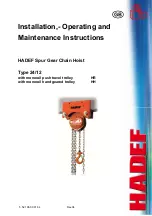
www.tigerlifting.com
Unit 1, Greensfield Industrial Estate,
Willowburn Avenue,
ALNWICK, NE66 2DG
Email: [email protected]
www.tigerlifting.com
Page 12 of 38
Manual Tiger SS11-PLH En 201704 v3.2
Inspect the load chain
Inspect the load chain for sufficient lubrication, mechanical damage and check for external defects, deformations, superficial
cracks, wear, excessive rust and corrosion marks. Check for gouged, twisted and distorted links, and for deposits of foreign
material which may be carried into the lever hoist mechanism. Do not operate lever hoists with twisted, kinked or damaged
chain links. See Chapter 6 Chain and Hooks.
Inspection of the top hook and bottom load hook
The top and load hooks must be checked for cracks, deformations, damage, wear and corrosion marks. The safety latch must
be attached, move freely and be fully functioning. Hooks that are bent, worn or have openings which are enlarged beyond
normal throat opening (Chapter 12/Hooks) should not be used. If the latch does not engage in the throat opening of the hook,
the lever hoist should be taken out of service. Hooks that do not fulfil all requirements must be replaced immediately. See
Chapter 6 Chain and Hooks and Chapter 12 Technical Data/Hooks for more information. Welding on hooks, e.g. to compensate
for wear or damage is not permissible.
Inspection of chain reeving in the bottom block
All units with two or more chain falls must be inspected before initial operation to ensure that the load chain is not twisted or
kinked. The chains of hoists with two or more falls may become twisted if the bottom block is rolled over “capsized” (i.e.
bottom hook has looped through the multi fall chain). A twist in the load chain can damage the lever hoist and cause injury.
Inspection of the load chain anchoring
The load chain anchoring must always be fitted securely at both ends. There must be no wear or incorrect alignment.
And finally, listen (while hoist operates) for unusual sounds which may indicate trouble.
































